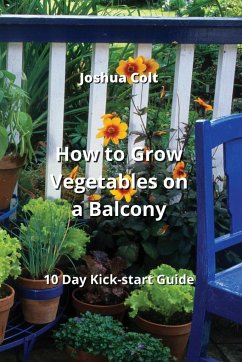Transforming your humble balcony into a thriving vegetable garden is a rewarding and sustainable way to enjoy fresh, homegrown produce right at your fingertips. Whether you have a small or spacious balcony, you can cultivate a vibrant vegetable garden that not only adds beauty to your outdoor space but also provides you with delicious, nutrient-rich vegetables. Here's your step-by-step guide on how to grow vegetables on a balcony: Assess Your Space: Start by evaluating your balcony's size, orientation, and sunlight exposure. Most vegetables require at least 6 hours of direct sunlight daily. Take note of the available space for containers and any vertical structures like railings or walls that can be utilized for growing. Choose the Right Containers: Select containers that are suitable for your balcony and the vegetables you want to grow. Options include pots, hanging baskets, window boxes, and vertical planters. Make sure they have drainage holes to prevent overwatering. Select Vegetable Varieties: Opt for vegetables that are well-suited to container gardening. Some excellent choices include tomatoes, peppers, lettuce, spinach, radishes, herbs (like basil and mint), and dwarf varieties of carrots or cucumbers. Consider your climate and space limitations when making your selection. Quality Soil and Compost: Use a high-quality potting mix enriched with compost. Good soil is essential for nutrient absorption and proper drainage. Avoid garden soil, as it can be too dense for containers. Planting and Spacing: Follow the recommended spacing guidelines for each vegetable. Overcrowding can lead to poor growth and disease. Use trellises or stakes for vining plants like tomatoes and cucumbers to save space. Watering: Balcony gardens can dry out quickly, so monitor soil moisture regularly. Water thoroughly when the top inch of soil feels dry, but be cautious not to overwater, as it can lead to root rot. Fertilize: Use a balanced, slow-release fertilizer or organic compost to provide essential nutrients. Follow the instructions on the product label, as container plants often need more frequent feeding. Pest and Disease Management: Keep an eye out for pests like aphids or caterpillars and take prompt action if you spot any. Consider using natural remedies or organic pesticides to protect your plants. Support and Pruning: Use stakes, cages, or trellises to support your plants as they grow. Prune them regularly to encourage airflow and prevent overcrowding. Harvesting: Harvest your vegetables when they are ripe. Regular harvesting encourages more production. Be gentle to avoid damaging the plant. Enjoy the Bounty: Revel in the satisfaction of plucking fresh, homegrown vegetables from your balcony garden. Use them in your favorite recipes to savor the taste of your hard work. Continuous Learning: Gardening is a continuous learning experience. Take note of what works best on your balcony and adapt your practices accordingly. Experiment with new vegetables and techniques to enhance your gardening skills. By following these steps and nurturing your balcony vegetable garden with care, you'll be able to enjoy a bountiful harvest of fresh and organic produce while making the most of your outdoor space, no matter how small it may be. Happy gardening!








